318. The Mamari (Egg) tablet was rounded and not rectangular in form (like the G tablet)
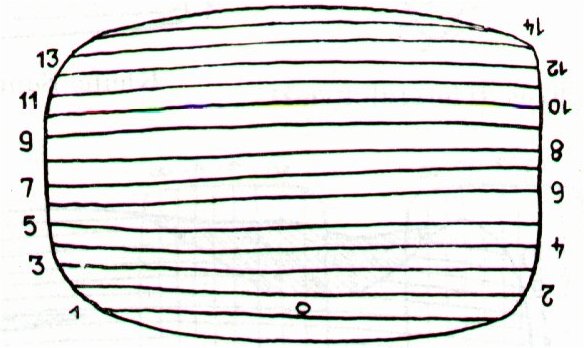 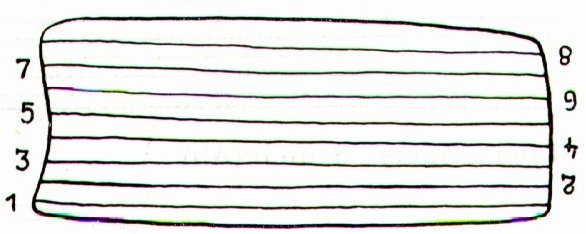
and its number of lines were 28 (and not 16) as if a hint of the nights of the Moon. As I have interpreted the text we should connect its glyphs primarily with the positions of the Full Moon - rather than with the heliacal positions of the stars (as in the G text).
| JAN 31 (396) |
FEBR 1 |
2 |
3 |
4 (*320) |
5 (36) |
 |
 |
 |
 |
 |
 |
| *Ca14-18 |
*Ca14-19 |
*Ca14-20 |
*Ca14-21 (384) |
*Ca14-22 |
*Ca14-23 |
| te honu paka |
te henua |
honu kau |
te mata |
te honu |
kua heheu |
|
Paka. 1. Dry; to become dry (of things); pakapaka, to dry out. Te paka is also the name of the moss-covered areas, between the small lakes of volcano Rano Kau, through which one can pass without getting one's feet wet. 2. To go, to depart; he-paka-mai, to come; he-oho, he-paka, they go away. 3. To become calm (of the sea): ku-paka-á te tai. Pakahera, skull, shell, cranium; pakahera puoko tagata, human skull; pakahera pikea, shell of crab or crayfish. Gutu pakapaka, scabbed lips. Hau paka, fibres of the hauhau tree, which were first soaked in water, then dried to produce a strong thread. Moa gao verapaka, chicken with bald neck. Ariki Paka, certain collateral descendents of Hotu Matu'a, who exercised religious functions. Vanaga. 1. Crust, scab, scurf; paka rerere, cancer; pakapaka, crust, scabby. 2. Calm, still. 3. Intensive; vera paka, scorching hot; marego paka, bald; nunu paka, thin. 4. To arrive, to come. 5. To be eager. 6. To absorb. 7. Shin T. Pakahera, calabash, shell, jug. Pakahia, to clot, curdle, coagulate. Pakapaka, dry, arid, scorching hot, cooked too much, a desert, to fade away, to roast, a cake, active; toto pakapaka, coagulated blood; hakapakapaka, to dry, to broil, to toast. Pakahera pikea, shell of crab or crayfish. Churchill. |
| 1h (15.2) β Phoenicis (15.1), υ Phoenicis, ι Tucanae (15.6), η Ceti, ζ Phoenicis (15.7) |
Al Batn Al Hūt-26 (Belly of the Fish) / Revati-28 (Prosperous) / 1-iku (Field Measure)
MIRACH (Girdle) = β Andromedae, KEUN MAN MUN (Camp's South Gate) = φ Andromedae (16.0), ANUNITUM = τ Piscium (16.5), REVATI (Abundant) = ζ Piscium (16.9)
REGULUS (α Leonis)
|
ν Phoenicis (17.4), κ Tucanae (17.6) |
no star listed (18) |
ADHIL (Garment's Train) = ξ Andromedae (19.3), θ Ceti (19.7) |
KSORA (Knee) = δ Cassiopeiae (20.1), ω Andromedae (20.6), γ Phoenicis (20.8) |
| CLOSE TO THE FULL MOON: |
 |
| 13h (197.8)
ξ¹ Centauri (197.1), ξ² Centauri (197.9) |
APAMI-ATSA (Child of Waters) = θ Virginis, ψ Hydrae (198.5), DIADEM = α Com. Ber. (198.9) |
AL DAFĪRAH (Tuft) = β Com. Ber. (199.4) |
σ Virginis (200.4) |
γ Hydrae (201.0), ι Centauri (201.4) |
Al Simāk-12 (Lofty) / Chitra-14 (Bright One) / Horn-1 (Crocodile) / Sa-Sha-Shirū-20 (Virgin's Girdle) / ANA-ROTO-3 (Middle pillar)
MIZAR = ζ Ursae Majoris (202.4), SPICA = α Virginis, ALCOR = 80 Ursae Majoris (202.7)
SADALMELIK (α Aquarii)
*161 = *202.4 - 41.4 |
|
... Possibly they used the nakshatra method and found Apami-Atsa (θ Virginis) close to the Full Moon, corresponding in Babylonian times to day 214 (AUGUST 2) - i.e. 'a day for all hearts'. ... Apami-Atsa ('Child of Waters', θ Virginis) at 13h maybe should be contrasted with Apam Napat ('Grandson of Waters') ... θ is on the front of the garment, below the girdle ... Moderns have no name for it, but in the Surya Siddhanta it was Apami-Atsa, the Child of the Waters ...
... Apam Napat is an eminent figure of the Indo-Iranian pantheon. In Hinduism, Apām Napāt is the god of fresh water, such as in rivers and lakes. In Zoroastrianism, Apąm Napāt is also a divinity of water ... Apām Napāt in Sanskrit and Apąm Napāt in Avestan mean 'grandson of waters' ... Sanskrit and Avestan napāt ('grandson') are cognate to Latin nepōs and English nephew, but the name Apām Napāt has also been compared to Etruscan Nethuns and Celtic Nechtan and Roman Neptune. In Yasht 19 of the Avesta Apąm Napāt appears as the Creator of mankind. Here, there is an evident link between the glory of sovereignty (Khvarenah) and Apąm Napāt who protects Khvarenah as the royal glory of Iranian kings. Apām Napāt is sometimes, for example in Rigveda book 2 hymn 35 verse 3, described as a fire-god who originates in water ... The reference to fire may have originally referred to flames from natural gas or oil seepages surfacing through water, as in a fire temple at Surakhany near Baku in Azerbaijan ... There is a conjecture that the word 'naphtha' came (via Greek, where it meant any sort of petroleum) from the name 'Apampat' ... |
| AUG 1 |
2 (214) |
3 |
4 (*136 = *200 - *64) |
5 (*320 - *183) |
6 (36 + 182) |
| FEBR 6 |
7 (365 + 38 = 403) |
8 (*324) |
9 (40) |
10 |
11 (224 - 182) |
 |
 |
 |
 |
 |
 |
| *Ca14-24 |
*Ca14-25 |
*Ca14-26 (→ 364) |
*Ca14-27 |
*Ca14-28 |
*Ca14-29 (392) |
| te henua |
te honu kau |
manu kake rua |
te henua |
te honu |
te rima |
| δ Phoenicis (21.5) |
υ Andromedae (22.9) |
ACHERNAR = α Eridani (23.3), χ Andromedae (23.6), τ Andromedae (23.9) |
ALSEIPH (Scimitar) = φ Persei (24.5), τ Ceti (24.7) |
no star listed (25) |
ANA-NIA-10 (Pillar-to-fish by) χ Ceti (26.1), POLARIS = α Ursae Minoris, BATEN KAITOS (Belly of the Fish) = ζ Ceti (26.6), METALLAH = α Trianguli (26.9) |
| CLOSE TO THE FULL MOON: |
 |
| 71 VIRGINIS (203.6) |
no star listed (204) |
HEZE = ζ Virginis (205.0), Southern Pinwheel Galaxy = M83 Hydrae (205.7) |
ε Centauri (206.3), κ Oct. (206.4) |
no star listed (207) |
τ Bootis (208.2), BENETNASH (Leader of the Daughters of the Bier) = η Ursae Majoris (208.5), ν Centauri (208.7), μ Centauri, υ Bootis (208.8) |
| AUG 7 |
8 (*140 = 365 - 225) |
9 |
10 |
11 |
12 (224) |
 |
Here Virgo was at the Full Moon with 5 turtle glyphs at the end of the text on side a. The beginning of side b was at the First Point of Aries with a 6th turtle (which we possibly should connect with the fact that in 3 out of 5 surfing days Ira did not accompany the other 5 explorers when they acted like turtles):
| FEBR 12 (408 = 365 + 43) |
13 |
2-14 (45) |
15 |
 |
 |
 |
 |
| Cb1-1 (393) |
Cb1-2 |
Cb1-3 |
Cb1-4 (396) |
| E tupu - ki roto - o te hau tea |
ki te henua - te maro |
| Al Sharatain-1 / Ashvini-1 / Bond-16 (Dog) / Mahrū-sha-rishu-ku-1 (Front of the Head of Ku) SEGIN = ε Cassiopeia, MESARTHIM = γ Arietis, ψ Phoenicis (27.2), SHERATAN (Pair of Signs) = β Arietis, φ Phoenicis (27.4) |
ι Arietis (28.0), λ Arietis (28.2), υ Ceti (28.8) |
ALRISHA (The Knot) = α Piscium, χ Phoenicis (29.2), ALAMAK (Caracal) = γ Andromedae (29.7) |
Arku-sha-rishu-ku-2 (Back of the Head of Ku)
2h (30.4)
κ Arietis (30.3), HAMAL (Sheep) = α Arietis (30.5)
ALKES (α Crateris)
|
 |
| CLOSE TO THE FULL MOON: |
| no star listed (209) |
MUPHRID (Solitary Star) = η Bootis (210.1), ζ Centauri (210.3) |
φ Centauri (211.0), υ¹ Centauri (211.1), υ² Centauri (211.8), τ Virginis (211.9) |
AGENA (At the Knee) = β Centauri (212.1), θ Apodis (212.5), THUBAN (Dragon) = α Draconis (212.8) |
|
... only Ira did not go down to let himself be carried on a board by a wave ... |
| AUG 13 (225 = 15 * 15) |
14 (*146) |
15 (227 → π) |
16 (46 + 182) |
Also the comparatively short K text - which runs in parallel with the G text from the beginning of its side a up to approximately the time of heliacal Antares - has turtles (honu glyphs) here:
 |
 |
 |
 |
 |
 |
 |
 |
|
Ga5-22 |
Ga5-23 |
Ga5-24 |
Ga5-25 |
Ga5-26 |
Ga5-27 |
Ga5-28 |
Ga5-29 |
 |
 |
 |
 |
... |
 |
- |
 |
|
Kb2-1 (120 - 7) |
Kb2-2 |
Kb2-3 |
Kb2-4 |
*Kb2-6 |
*Kb2-7 (118) |
| a1 |
19 |
*5 |
*24 |
24 |
b1 |
20 |
*2 |
*22 |
119 |
| a2 |
22 |
- |
22 |
46 |
b2 |
17 |
*1 |
*18 |
137 |
| a3 |
21 |
- |
21 |
67 |
b3 |
16 |
- |
16 |
153 |
| a4 |
16 |
- |
16 |
83 |
b4 |
19 |
- |
19 |
172 |
| a5 |
14 |
- |
14 |
97 |
b5 |
17 |
*3 |
*20 |
192 |
| sum |
92 |
*5 |
*97 |
sum |
89 |
*6 |
*95 |
|
Numbers with asterisk (*) are reconstructed by me because the glyphs appear to have been destroyed. But the idea of the creator of the text could have been to put in parallel 181 (92 + 89) glyphs with 192 glyph positions. At the time of rongorongo the right ascension distance from Aldebaran to Antares was 181 days
| Northern summer: |
183 |
 |
180 |
 |
| α Tauri |
α Scorpii |
| 182 = 13 * 14 days |
| Southern winter |
and 192 was the day number for July 11 when Antares culminated (at 21h). At the time of Bharani this culmination date had been 192 - 41 = 151 ("May 31), i.e. the day before the Explorers reached Easter Island.
... [E:17] On the twenty-fifth day of the first month (Vaitu Nui), Ira and Makoi set sail; on the first day of June ('Maro'), the bow of Ira's canoe appeared on the distant horizon, came closer and closer on its course, and sailed along, and finally (one) could see the (new home) land ... |
The Earth Turtle - perhaps identified in the Mayan so-called Nunnery building - meant the 'surface of the earth':
... An iconographic study by Jeff Kowalski suggests a cosmological layout for the Nunnery. The higher placement of the North Building, with its 13 exterior doorways (reflecting the 13 layers of heaven), and the celestial serpents surmounting the huts identify it with the celestial sphere. The iconography of the West Building, with 7 exterior doorways (7 is the mystic number of the earth's surface), and figures of Pawahtun - the earth god as a turtle - indicate this to be the Middleworld, the place of the sun's descent into the Underworld. The East Building has mosaic elements reflecting the old war cult of Teotihuacan, where tradition had it that the sun was born; thus, this may also be Middleworld, the place of the rising sun. Finally, the South Building has 9 exterior doorways (the Underworld or Xibalba had 9 layers), and has the lowest placement in the compex; it thus seems to be associated with death and the nether regions ...

I have earlier been inclined to connect this Pawahtun turtle with the equinoxes:
... In the most general sense, the 'earth' was the ideal plane laid through the ecliptic. The 'dry earth', in a more specific sense, was the ideal plane going through the celestial equator. The equator thus divided two halves of the zodiac which ran on the ecliptic, 23 ½º inclined to the equator, one half being 'dry land' (the northern band of the zodiac, reaching from the vernal to the autumnal equinox), the other representing the 'waters below' the equinoctial plane (the southern arc of the zodiac, reaching from the autumnal equinox, via the winter solstice, to the vernal equinox. The terms 'vernal equinox', 'winter solstice', etc., are used intentionally because myth deals with time, periods of time which correspond to angular measures, and not with tracts in space ...

However, the Mayas had a turtle which appears to prove it primarily was the surface as defined by the sky equator (between the upper and lower sky shells).
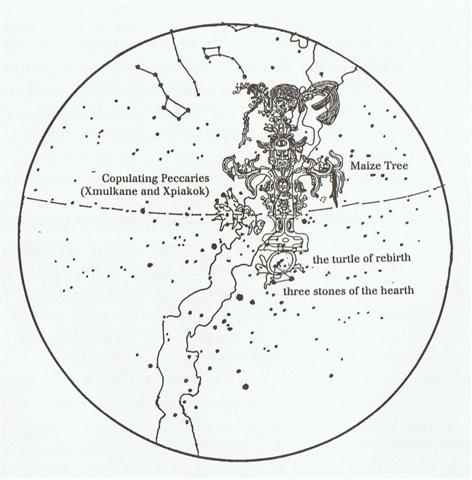
Furthermore, the Child of Waters (θ Virginis) was above the ecliptic but below 0º - i.e. presumably 'down in the cup of water'.

Both the Orion and Virgo were great ancient constellations straddling the declination line of 0°. But of course there must have been a time when also Spica had been at 0h. Or rather at midsummer:

... The Mnajdra Temple is located on Malta and very ancient, dating to the time before the pyramids. Marija Gimbutas: 'To sleep within the Goddess's womb was to die and to come to life anew'. In a system of reincarnation the old one must die in order to be reborn, of course. At midsummer Sun comes to a standstill, and this must therefore be an occasion when the 'flame of life' had to be transported into a new body.
... Then I become aware of ... a presence - a faint, ghostly glimmering, like moonglow, that has appeared on the solstice stone. I don't know how long it lasts, a second or two only I would guess, but while it is there it seems less like a projection - which I know it to be - than something immanent within the stone itself. And it seems to function as a herald for it fades almost as soon as it has appeared and in its place the full effect snaps on - instantaneously. It wasn't there, and then it's there. As Chris had described, the effect does curiously resemble a poleaxe, or a flag on a pole, and consists of a 'shaft', narrow at the base but widening a little towards the top, running up the left hand side of the solstice stone, surmounted by a right-facing 'head' or 'flag'. An instant later an almond-shaped spot of light, like an eye, appears a few centimeters to the right of the 'flag' and the effect is complete. Weirdly - I do not claim it has any significance - this flag-on-a-pole symbol is the ancient Egyptian hieroglyph neter, meaning 'god', or 'a god' - and not to be understood at all in the Judaeo-Christian usage of that word but rather as a reference to one of the supernatural powers or principles that guide and balance the universe. Manifested here, in this strange Stone Age temple, it glows, as though lit by inner fire.'
Neter, the Egyptian hieroglyph for 'God', could be equivalent to the toki type of glyph:
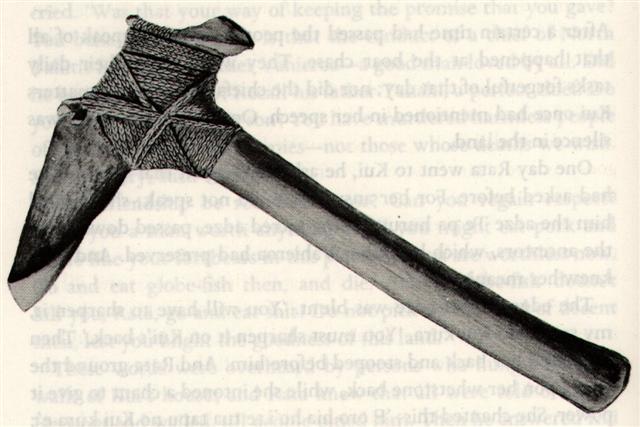
| Toki. Small basalt axe. Vanaga. Stone adze. Van Tilburg. Ha'amoe ra'a toki = 'Put the adze to sleep' (i.e. hide it in the temple during the night). Barthel. Month of the ancient Rapanui calendar. Fedorova according to Fischer. To'i. T. Stone adze (e to'i purepure = with the wounderful adze). Henry. The Araukan Indians in the coastal area of northern Chile, have customs similar to those on the Marquesas and in both areas toki means adze according to José Imbelloni. The Araukans also called their chief of war toki and the ceremonial adze symbolized his function and was exhibited at the outbreak of war. In Polynesia Toki was the name of a chief elevated by the Gods and his sign was the blade of a toki. Fraser. Axe, stone hatchet, stone tool ...; maea toki, hard slates, black, red, and gray, used for axes T. P Pau.: toki, to strike, the edge of tools, an iron hatchet. Mgv.: toki, an adze. Mq.: toki, axe, hatchet. Ta.: toi, axe. Churchill. A Maori saying: he iti toki, e rite ana ki te tangata = though the adze be small, yet does it equal a man. (Starzecka) |
Counting from Ga2-1, where Canopus rose heliacally, to Spica in Virgo the distance was *202 - *95 = *107 days (= 4 * 118 - 365). I.e., 107 precessional days before the time of rongorongo Ana-roto would have been around where Canopus now was.
And at that ancient time Canopus would have risen with the Sun in around day 175 (June 25) - 107 = 68, but rather regarded to be in day 175 - 107 + 16 = 84 (Julian equinox), because we can guess that at that ancient time it was rather the return of Canopus to visibility which counted.
| APRIL 17 (80 + 27) |
18 (108) |
19 (*29) |
20 |
21 (84 + 27 = 111) |
100 |
 |
 |
 |
 |
 |
| Ga1-27 |
Ga1-28 |
Ga1-29 |
Ga1-30 |
(33) Ga2-1 (32) |
| 6h (91.3)
ν Orionis (91.4), θ Columbae (91.5), π Columbae (91.6) |
ξ Orionis (92.5) |
Al Han'ah-4 (Brand) / Maru-sha-pu-u-mash-mashu-7 (Front of the Mouth of the Twins) TEJAT PRIOR = η Gemini (93.4), γ Monocerotis (93.5), κ Aurigae (93.6), κ Columbae (93.8) |
FURUD = ζ Canis Majoris (94.9) |
Well-22 (Tapir) / Arkū-sha-pu-u-mash-mashu-8 (Back of the Mouth of the Twins) δ Columbae (95.2), TEJAT POSTERIOR = μ Gemini, MIRZAM (Roarer) = β Canis Majoris (95.4), CANOPUS = α Carinae (95.6), ε Monocerotis (95.7), ψ1 Aurigae (95.9) |
|
... Murzim [β Canis Majoris], generally but less correctly Mirzam, and occasionally Mirza, is from Al Murzim, the Announcer², often combined by the Arabs with β Canis Minoris in the plural Al Mirzamāni, or as Al Mirzamā al Shi'rayain, the two Sirian Announcers; Ideler's idea of the applicability of this title being that this star announced the immediate rising of the still brighter Sirius. ² Literally the Roarer, and so another of the many words in the Arabic tongue for the lion, of which that people boasted of having four hundred ... |
| June 20 |
SOLSTICE |
22 (*93) |
23 (174) |
ST JOHN'S DAY |
| °June 16 |
17 (168) |
18 |
19 |
20 (*91) |
| 24 (*64 = *50 + *14) |
'May 25 |
26 |
27 |
28 (*68) |
| "May 10 (*91.4 - *41.4) |
11 |
12 (*93.4 - *41.4 = *52) |
13 |
14 (*54 = *95.4 - *41.4) |
| CLOSE TO THE FULL MOON: |
| OCT 17 (290) |
18 |
19 |
20 |
21 (*214) |
|
... She planted her potatoes 7 in a row, placing her foot in front of her as a measure from one potato to the next. Then she marked the place with a bean - which would also give nourishment to the surrounding potatoes. Next she changed variety and planted 7 more followed by another bean, and this was the pattern she followed until all her 214 varieties had been put down in their proper places. She had drawn a map which she followed and from where each sort of potato could be located at the proper time for its harvest. I was fashinated, when I happened to stumble on this Swedish TV program, because my 'once upon a time' was now and 214 (= 2 * 107) was surely no coincidence. She knew what she was doing. Let's therefore count: 214 * 7 (potatoes) + 213 (beans) = 1711. So what? Probably because 1711 = 59 * 29 ...
... The Hawaiian woman who was interviewed chuckled because the assassination of Captain Cook coincided with the day we have named All Hearts' Day - when in February 14 (2-14) the war-god Kuu returned to power. The assassination of Julius Caesar came a month (29 days) later (and 365 - 29 = 336 = 14 * 24 = 12 * 28) ... |
| ZHŌNGSHĀN = ο Herculis (274.0), π Pavonis (274.6) |
ι Pavonis (275.1), POLIS = μ Sagittarii (275.9)
MENKAR (α Ceti)
|
η Sagittarii (276.9) |
Purva Ashadha-20 (Winnowing Basket) |
| KAUS AUSTRALIS = Ε(lsie) Sagittarii , κ Lyrae (277.5), TUNG HAE (Heavenly Eastern Sea) = η Serpentis (277.7), SHAOU PIH (Minor Minister) = φ Draconis (277.8), KWEI SHE = χ Draconis (277.9) |
φ Oct. (278.1), KAUS BOREALIS = Λ(acie) Sagittarii (278.3), ξ Pavonis (278.4), AL ATHFAR (The Talons of the Falling Eagle) = μ Lyrae (278.6) |
|
... 'Tell us a story!' said the March Hare. 'Yes, please do!' pleaded Alice. 'And be quick about it', added the Hatter, 'or you'll be asleep again before it's done.' 'Once upon a time there were three little sisters', the Dormouse began in a great hurry: 'and their names were Elsie, Lacie, and Tillie; and they lived at the bottom of a well — '
.jpg)

|
| Dec 20 (354) |
SOLSTICE |
22 |
23 (*236 + *41) |
CHRISTMAS EVE |
| °Dec 16 |
17 |
18 |
19 (*273 = 236 + 37) |
20 (354 = 12 * 29½) |
| 'Nov 23 (327) |
24 |
25 |
26 (*250 = 236 + 14) |
27 |
| "Nov 9 |
10 (314) |
11 |
(*236 = 8 * 29½) |
13 |
|
... As has already been mentioned, the Delphians worshipped Dionysus once a year as the new-born child, Liknites, 'the Child in the Harvest Basket', which was a shovel-shaped basket of rush and osier used as a harvest basket, a cradle, a manger, and a winnowing-fan for tossing the grain up into the air against the wind, to separate it from the chaff. The worship of the Divine Child was established in Minoan Crete, its most famous early home in Europe. In 1903, on the site of the temple of Dictaean Zeues - the Zeus who was yearly born in Rhea's cave at Dicte near Cnossos, where Pythagoras spent 'thrice nine hallowed days' [27] of his initiation - was found a Greek hymn which seems to preserve the original Minoan formula in which the gypsum-powdered, sword-dancing Curetes, or tutors, saluted the Child at his birthday feast. In it he is hailed as 'the Cronian one' who comes yearly to Dicte mounted on a sow and escorted by a spirit-throng, and begged for peace and plenty as a reward for their joyful leaps ...

|
| JULY 31 |
AUG 1 |
2 (214) |
3 (*500) |
4 (*136) |
5 |
6 |
 |
 |
 |
 |
 |
 |
 |
| Ga5-22 |
Ga5-23 |
Ga5-24 |
Ga5-25 (135) |
Ga5-26 |
Ga5-27 (→ 364) |
Ga5-28 |
| δ Muscae (196.5) , VINDEMIATRIX (Grape Gatherer) = ε Virginis (196.8) |
13h (197.8)
ξ¹ Centauri (197.1), ξ² Centauri (197.9) |
APAMI-ATSA (Child of Waters) = θ Virginis, ψ Hydrae (198.5),
DIADEM = α Com. Ber. (198.9) |
AL DAFĪRAH (Tuft) = β Com. Ber. (199.4) |
σ Virginis (200.4) |
γ Hydrae (201.0), ι Centauri (201.4) |
Al Simāk-12 (Lofty) / Chitra-14 (Bright One) / Horn-1 (Crocodile) / Sa-Sha-Shirū-20 (Virgin's Girdle) / ANA-ROTO-3 (Middle pillar)
MIZAR = ζ Ursae Majoris (202.4), SPICA = α Virginis, ALCOR = 80 Ursae Majoris (202.7)
SADALMELIK (α Aquarii)
*161 = *202.4 - 41.4 |
 |
| Oct 3 |
4 |
5 |
6 |
7 (*200) |
8 |
9 (282) |
| °Sept 30 |
°Oct 1 |
2 |
3 (275) |
4 (*196) |
5 |
6 |
| 'Sept 6 |
7 (250) |
8 |
9 |
10 |
11 (364 - 100) |
12 (*175) |
| "Aug 23 |
24 (236 = 472 / 2) |
25 |
Hora Iti 26 |
27 |
28 (240) |
Hora Iti 29 |
|
Ahu. 1. Funerary monument with niches holding the skeletons of the dead. 2. Generic term for a grave, a tomb merely enclosed with stones. 3. Stone platform, with or without graves. 4. Elevated seat, throne. 5. Swollen; to swell up: ku-ahu-á tooku va'e, my foot is swollen; ananake te raá e-tagi-era te ûka riva mo toona matu'a ka-ahu ahu-ró te mata, every day the daughter cried for her parents until her eyes were quite swollen. Vanaga.
1. To transfer, to transplant, to take up by the roots. 2. To puff up, to swell, a swelling, protuberance; gutu ahu, swollen lips; ahuahu, to swell, plump, elephantiasis, dropsy; ahuahu pupuhi, amplitude; manava ahuahu, indigestion. 3. Paralysis. 4. A carved god of dancing, brought forth only on rare occasions and held of great potency. Ahuahu, inflammation. Ahukarukaru (ahu 2 - karukaru), dropsy. Churchill. |
Ahu Akapu
(2 days) |
Aka. 1. Anchor: he-hoa te aka, to drop anchor. 2. Root of certain plants (banana tree, taro, sugar-cane). 3. To be paralyzed by surprise. Vanaga.
1. Root; aka totoro, to take root. P Pau., Mq.: aka, root. Ta.: aa, id. 2. (āka) anchor. 3. Causative (haka). Churchill. |
Pu Pakakina
(1 month) |
| CLOSE TO THE FULL MOON: |
| JAN 30 |
31 (396) |
FEBR 1 |
2 |
3 |
4 (*320) |
5 (36) |
| PAPA O PEA |
... On the twenty-sixth day of the month of August ('Hora Iti') they went from Papa O Pea to Ahu Akapu. They all went and reached Ahu Akapu. They looked around and gave the name 'Ahu Akapu A Hau Maka'. They also saw (all of) Te Pito O Te Kainga, looked around, and gave (the whole island) the name 'Te Pito O Te Kainga A Hau Maka'. [E:31] They made camp and rested at Ahu Akapu for two days. On the twenty-ninth day of the month of August ('Hora Iti') they went to Pu Pakakina. They arrived, remained there, and gave the name 'Pu Pakakina A Ira'. They remained one month in Pu Pakakina. |
| no star listed (14) |
1h (15.2)
β Phoenicis (15.1), υ Phoenicis, ι Tu canae (15.6), η Ceti, ζ Phoenicis (15.7) |
Al Batn Al Hūt-26 (Belly of the Fish) / Revati-28 (Prosperous) / 1-iku (Field Measure)
MIRACH (Girdle) = β Andromedae, KEUN MAN MUN (Camp's South Gate) = φ Andromedae (16.0), ANUNITUM = τ Piscium (16.5), REVATI (Abundant) = ζ Piscium (16.9)
REGULUS (α Leonis)
|
ν Phoenicis (17.4), κ Tucanae (17.6) |
no star listed (18) |
ADHIL (Garment's Train) = ξ Andromedae (19.3), θ Ceti (19.7) |
KSORA (Knee) = δ Cassiopeiae (20.1), ω Andromedae (20.6), γ Phoenicis (20.8) |
| April 4 |
5 (460 = 396 + 64) |
6 |
7 |
8 (13 * 29½ - ½) |
9 (*384) |
10 (100) |
| °March 31 |
°April 1 (91) |
2 (*377) |
3 |
4 |
5 (460 = 396 + 64) |
6 (*16) |
| 'March 8 |
9 |
10 (*354 = 6 * 59) |
11 |
12 |
13 (72) |
3-14 |
| Tehetu'upú 22 |
TERMINALIA |
"Febr 24 (420) |
25 |
26 |
27 (*7 * 7 * 7) |
28 (59) |
|
... The leap day was introduced as part of the Julian reform. The day following the Terminalia (February 23) was doubled, forming the bis sextum - literally 'double sixth', since February 24 was 'the sixth day before the Kalends of March' using Roman inclusive counting (March 1 was the 'first day'). Although exceptions exist, the first day of the bis sextum (February 24) was usually regarded as the intercalated or 'bissextile' day since the third century. February 29 came to be regarded as the leap day when the Roman system of numbering days was replaced by sequential numbering in the late Middle Ages ... |
... In the inscriptions of Dendera, published by Dümichen, the goddess Hathor is called 'lady of every joy'. For once, Dümichen adds: Literally ... 'the lady of every heart circuit'. This is not to say that the Egyptians had discovered the circulation of the blood. But the determinative sign for 'heart' often figures as the plumb bob at the end of a plumb line coming from a well-known astronomical or surveying device, the merkhet. Evidently, 'heart' is something very specific, as it were the 'center of gravity' ... See Aeg.Wb. 2, pp. 55f. for sign of the heart (ib) as expressing generally 'the middle, the center '.
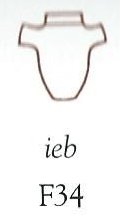
And this may lead in quite another direction. The Arabs preserved a name for Canopus - besides calling the star Kalb at-tai-man ('heart of the south') ... Suhail el-wezn, 'Canopus Ponderosus', the heavy-weighing Canopus, a name promptly declared meaningless by the experts, but which could well have belonged to an archaic system in which Canopus was the weight at the end of the plumb line, as befitted its important position as a heavy star at the South Pole of the 'waters below '.
Here is a chain of inferences which might or might not be valid, but it is allowable to test it, and no inference at all would come from the 'lady of every joy'. The line seems to state that Hathor (= Hat Hor, 'House of Horus') 'rules' the revolution of a specific celestial body - whether or not Canopus is alluded to - or, if we can trust the translation 'every', the revolution of all celestial bodies. As concerns the identity of the ruling lady, the greater possibility speaks for Sirius, but Venus cannot be excluded; in Mexico, too, Venus is called 'heart of the earth'
...
There was a leather thong leading up from Spica to the Fox star in Ursa Major and there could have been another line leading from Canopus to Spica.

| 1 |
Horn |
α Virginis (Spica) |
Crocodile |
(202.7) |
Oct 9 (282) |
| 2 |
Neck |
κ Virginis |
Dragon |
(214.8) |
Oct 21 (294) |
| 3 |
Root |
α Librae (Zuben Elgenubi) |
Badger |
(224.2) |
Oct 31 (304) |
| 4 |
Room |
π Scorpii (Vrischika) |
Hare |
(241.3) |
Nov 17 (321) |
| 5 |
Heart |
σ Scorpii |
Fox |
(247.0) |
Nov 23 (282 + 45) |
| 6 |
Tail |
μ Scorpii (Denebakrab) |
Tiger |
(254.7) |
Nov 30 (334) |
| 7 |
Winnowing Basket |
γ Sagittarii (Nash) |
Leopard |
(273.7) |
Dec 19 (353) |
| December solstice |
91 (= 107 - 16) precessional days earlier than the time of rongorongo Canopus would have been around the northern spring equinox and this could explain why he drank up all the waters (of winter):
... The Pythagoreans make Phaeton fall into Eridanus, burning part of its water, and glowing still at the time when the Argonauts passed by. Ovid stated that since the fall the Nile hides its sources. Rigveda 9.73.3 says that the Great Varuna has hidden the ocean. The Mahabharata tells in its own style why the 'heavenly Ganga' had to be brought down. At the end of the Golden Age (Krita Yuga) a class of Asura who had fought against the 'gods' hid themselves in the ocean where the gods could not reach them, and planned to overthrow the government. So the gods implored Agastya (Canopus, alpha Carinae = Eridu) for help. The great Rishi did as he was bidden, drank up the water of the ocean, and thus laid bare the enemies, who were then slain by the gods. But now, there was no ocean anymore! Implored by the gods to fill the sea again, the Holy One replied: 'That water in sooth hath been digested by me. Some other expedient, therefore, must be thought of by you, if ye desire to make endeavour to fill the ocean
...

... In Hindu tradition, Rahu is a cut-off head of an asura, that swallows the sun or the moon causing eclipses. He is depicted in art as a serpent with no body riding a chariot drawn by eight [8] black horses ... According to legend, during the Samudra manthan, the asura Rahu drank some of the divine nectar. Sun and moon realized it and they alerted Mohini (the female avatar of Vishnu). Before the nectar could pass his throat, Mohini cut off his head. The head, however, remained immortal. It is believed that this immortal head occasionally swallows the sun or the moon, causing eclipses. Then, the sun or moon passes through the opening at the neck, ending the eclipse ...
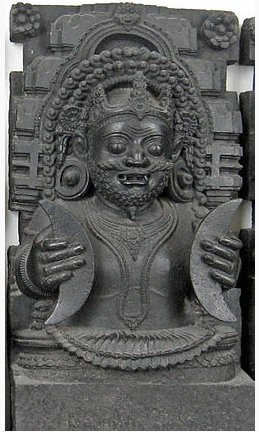
|




























.jpg)






